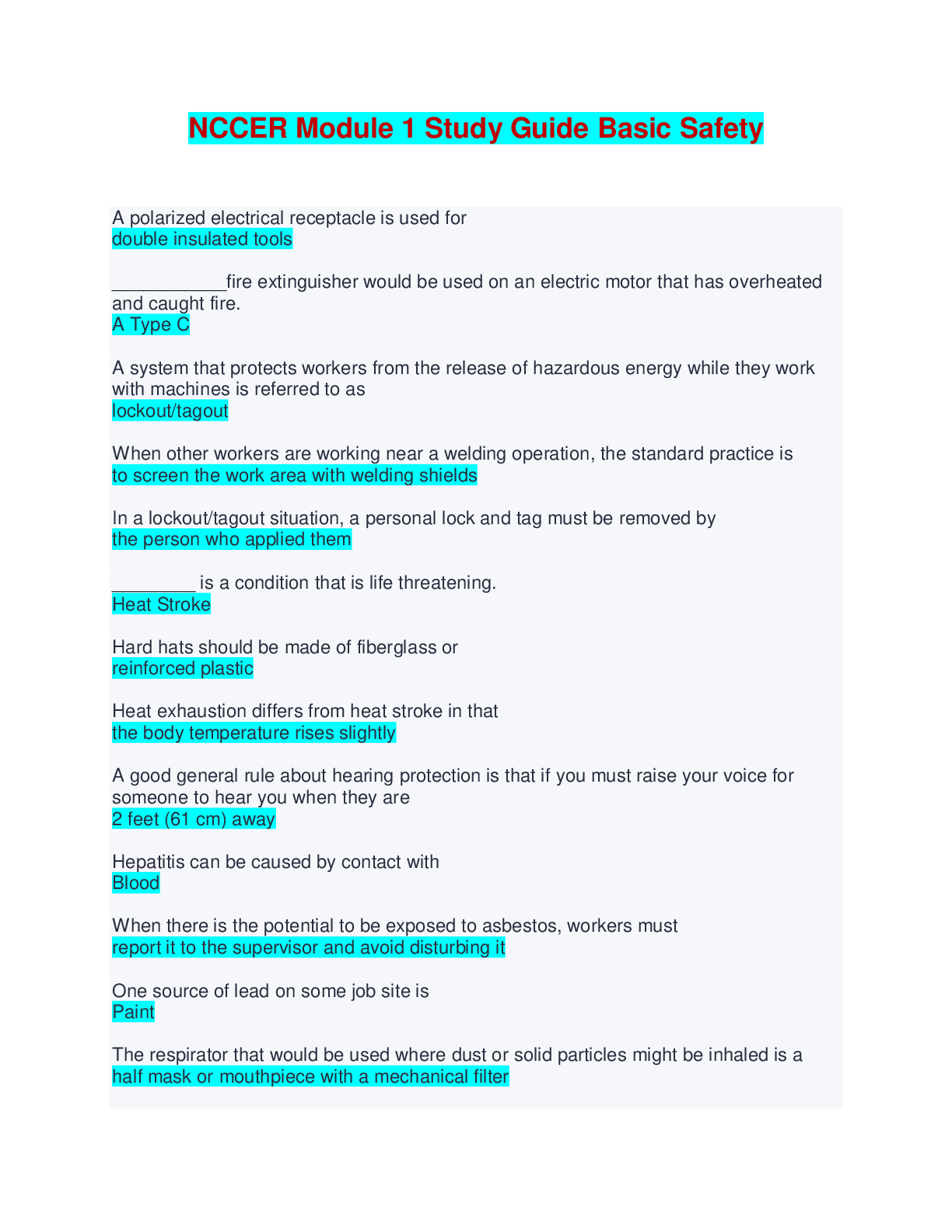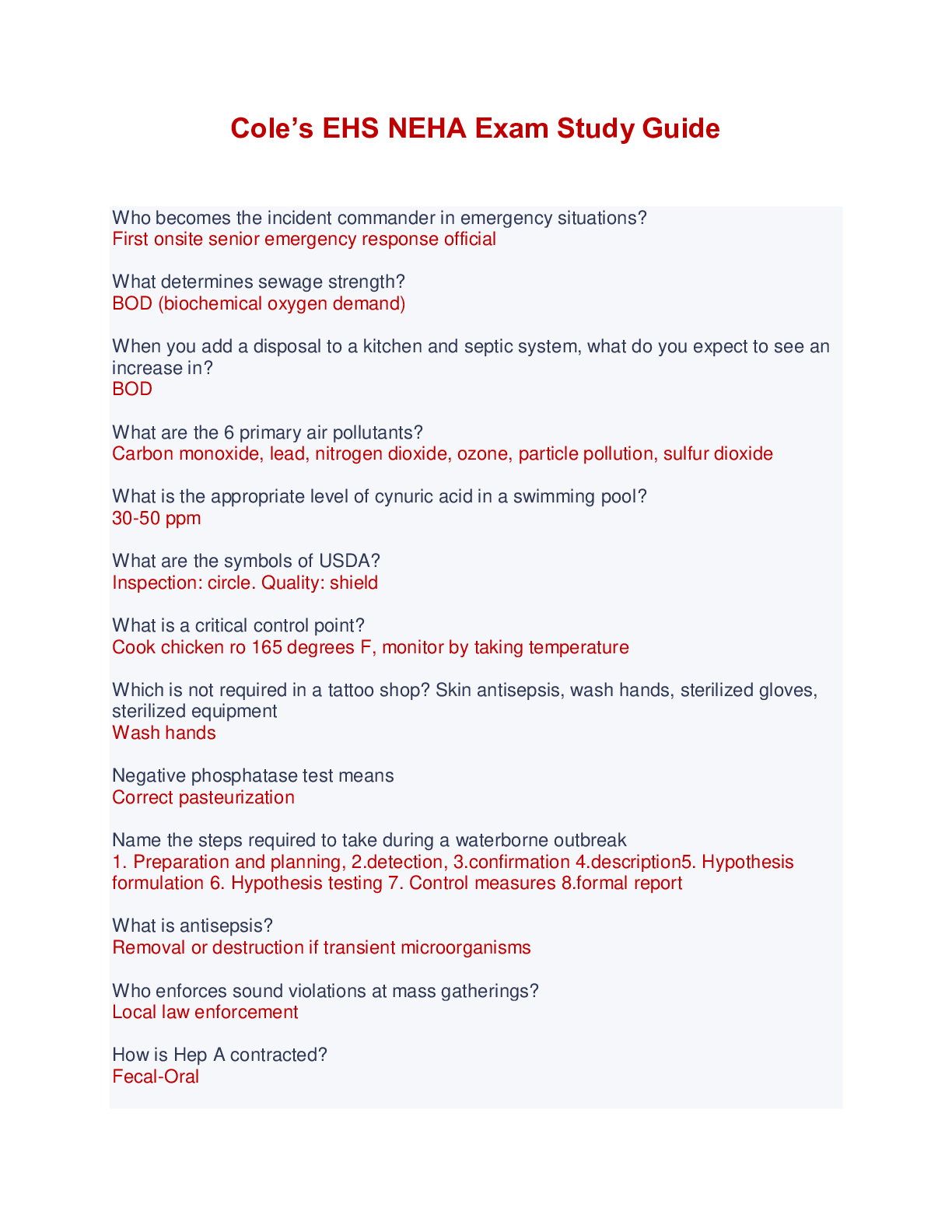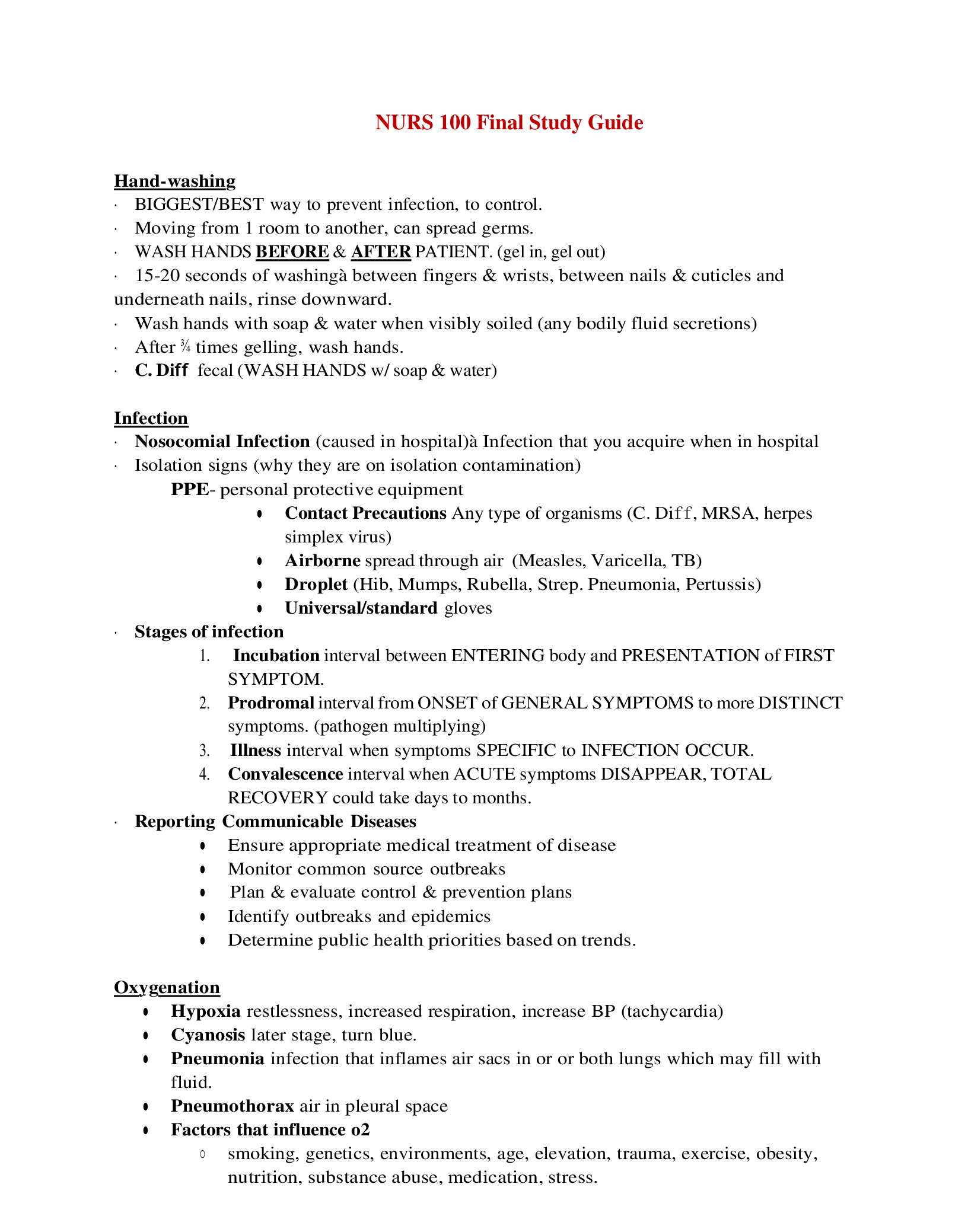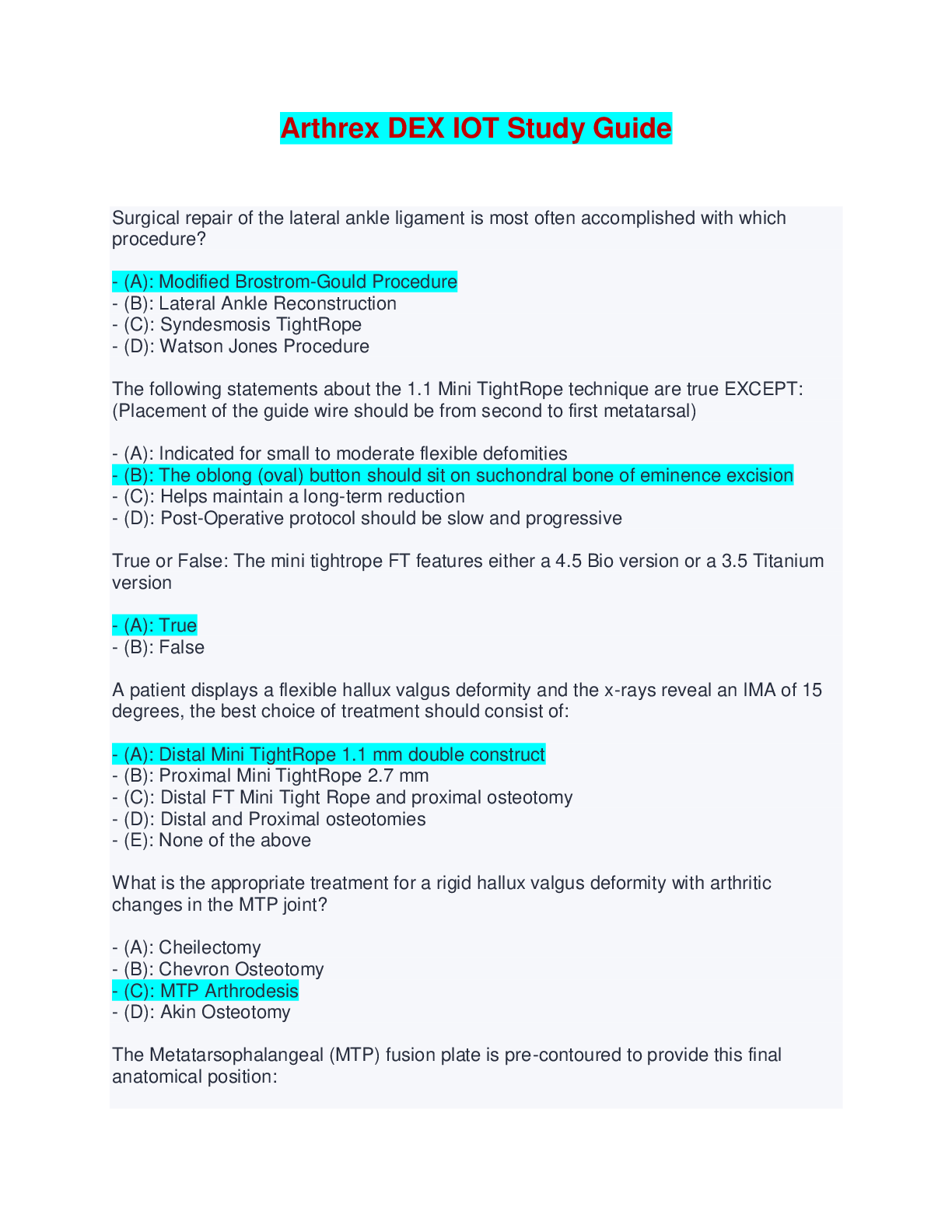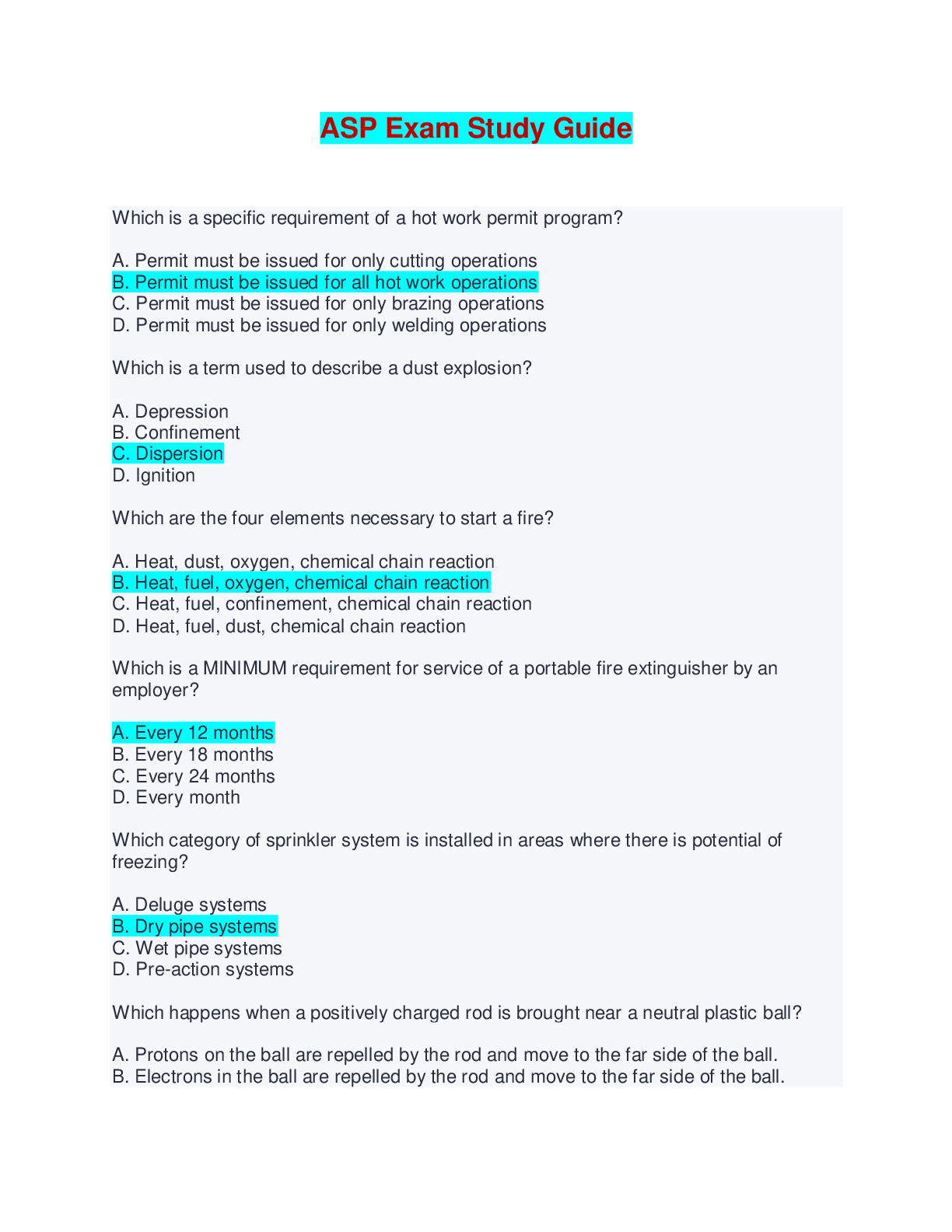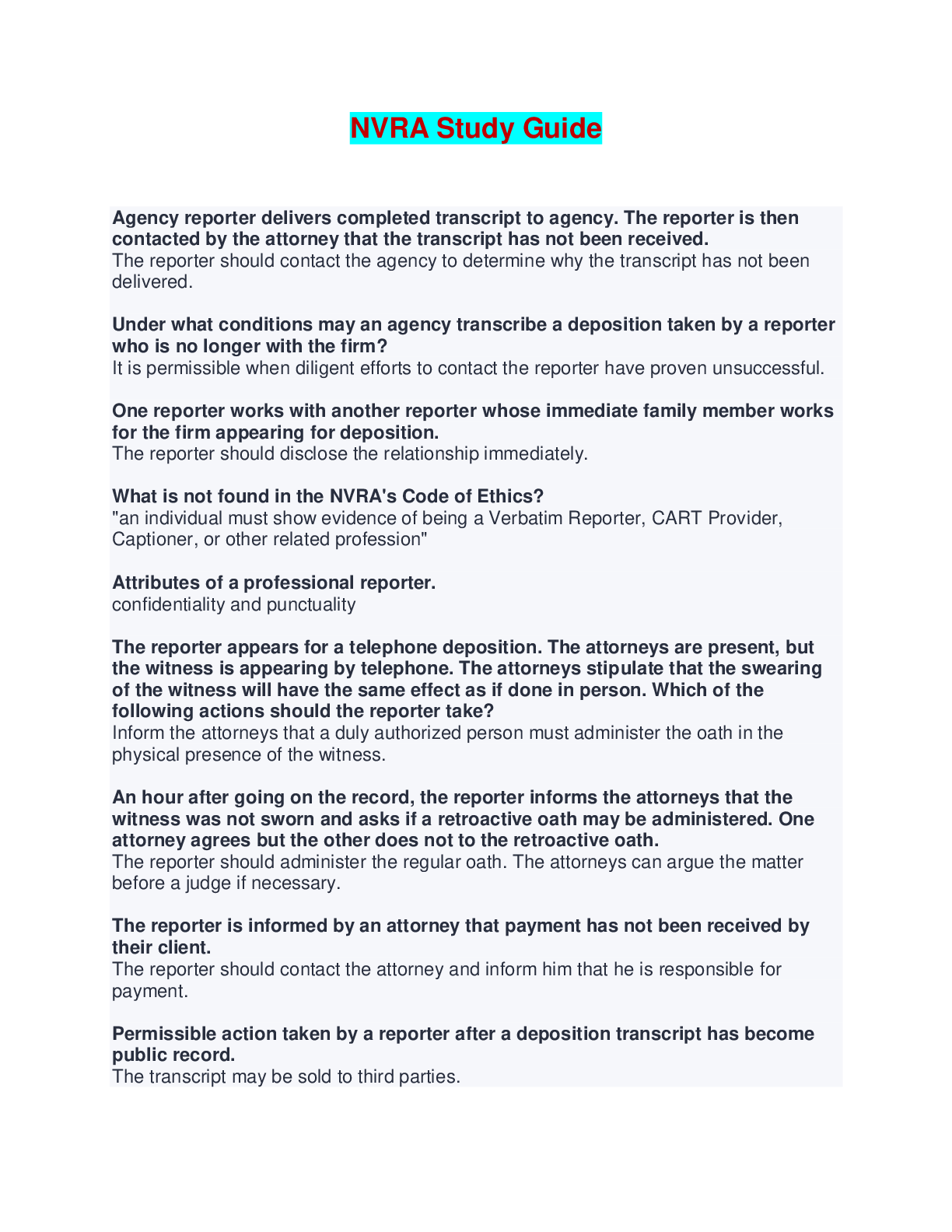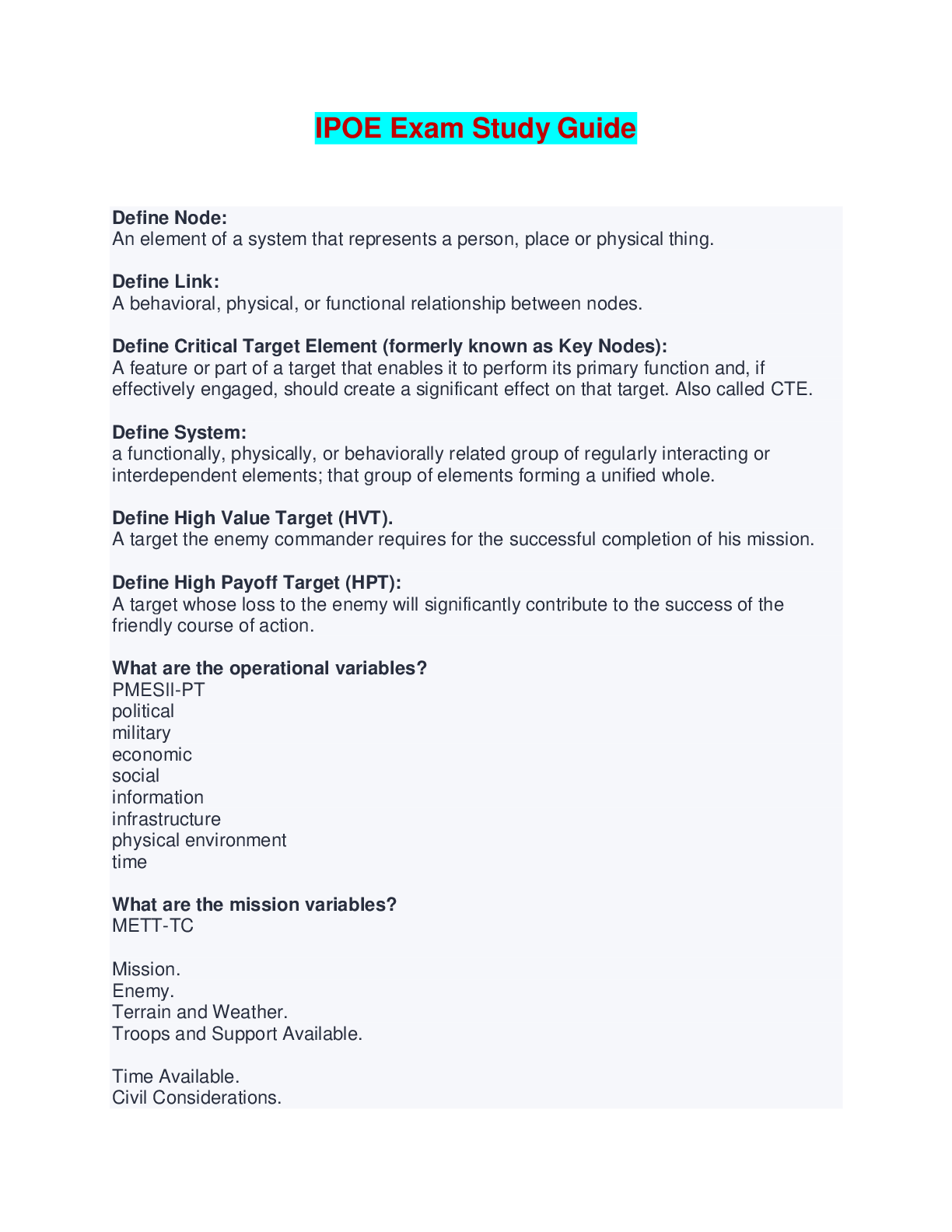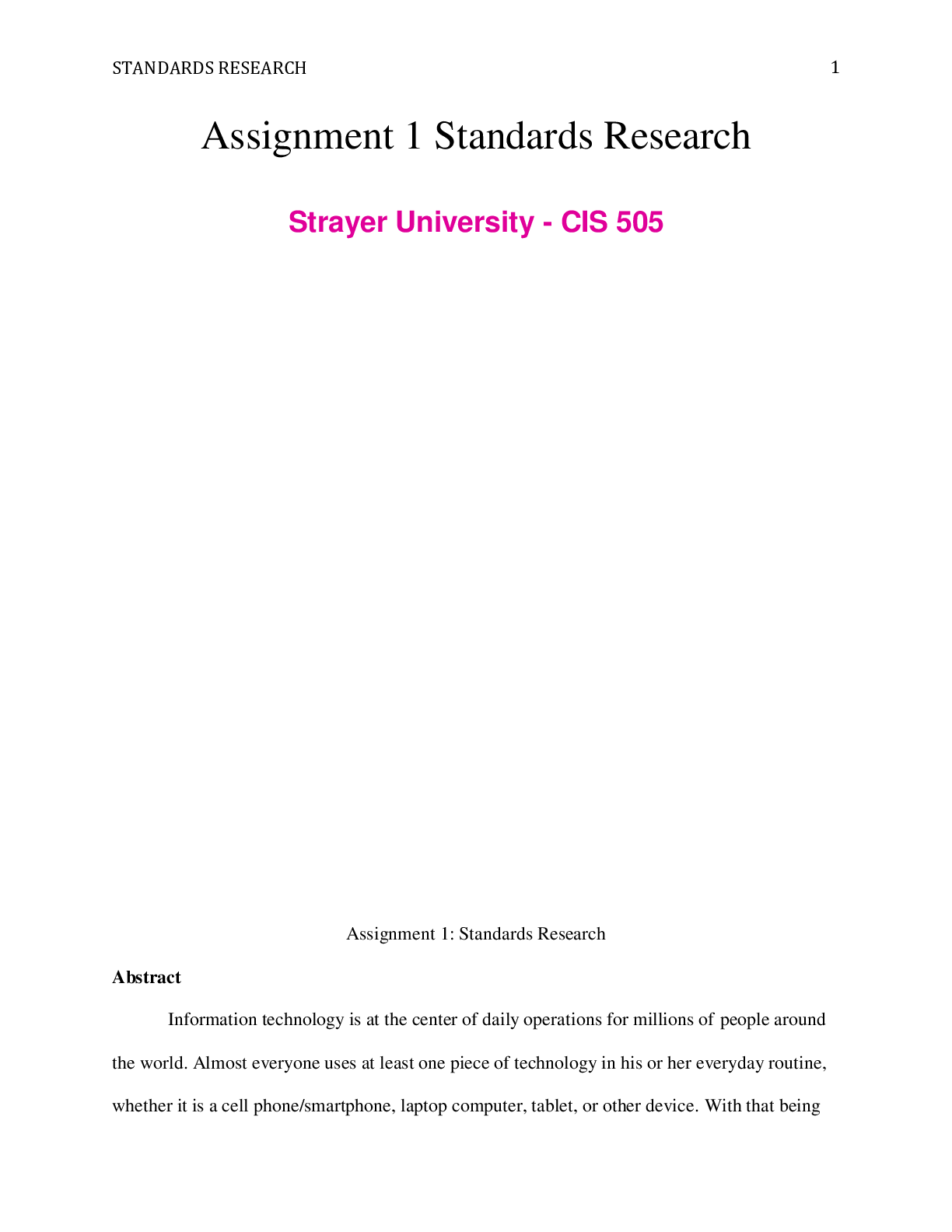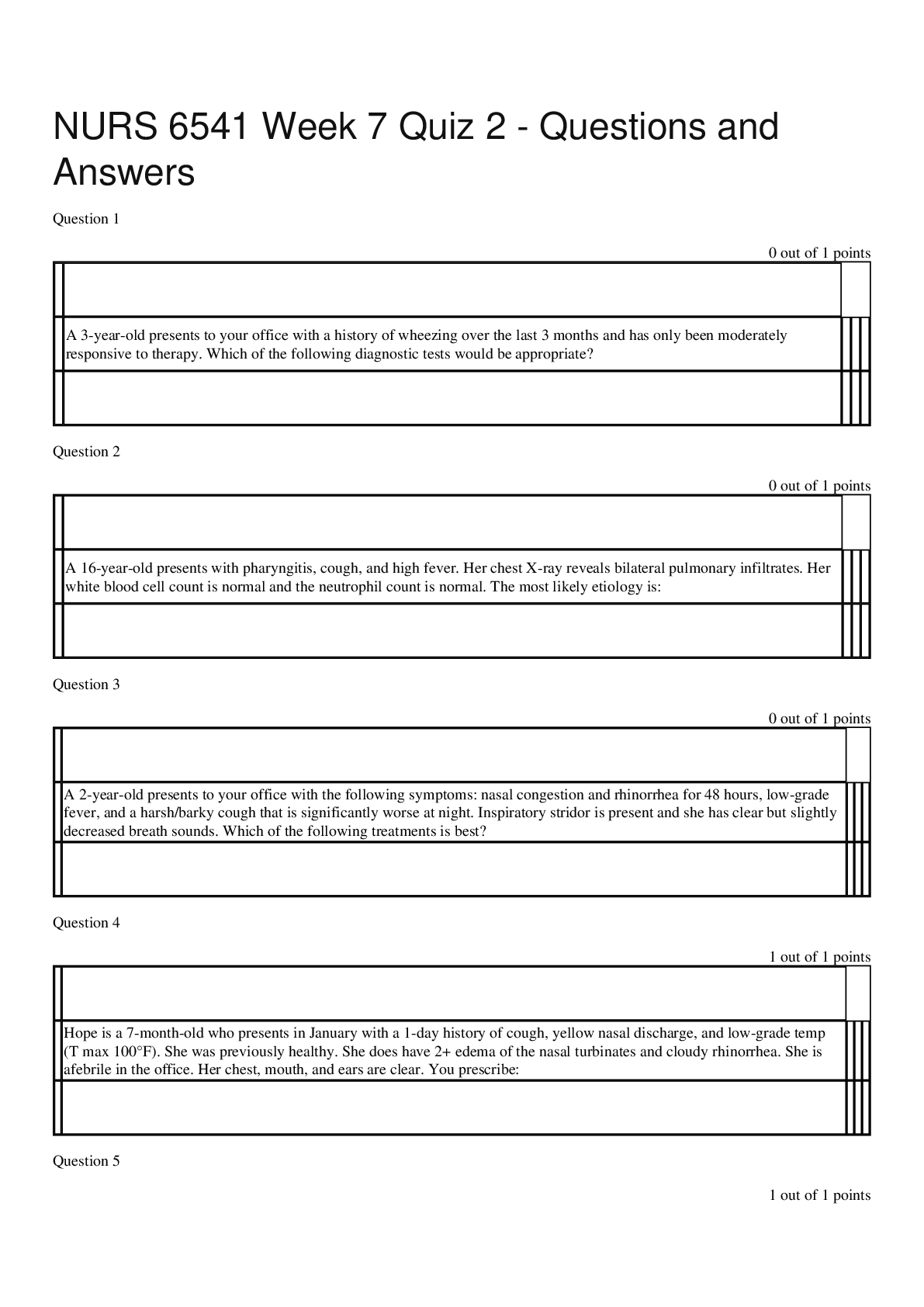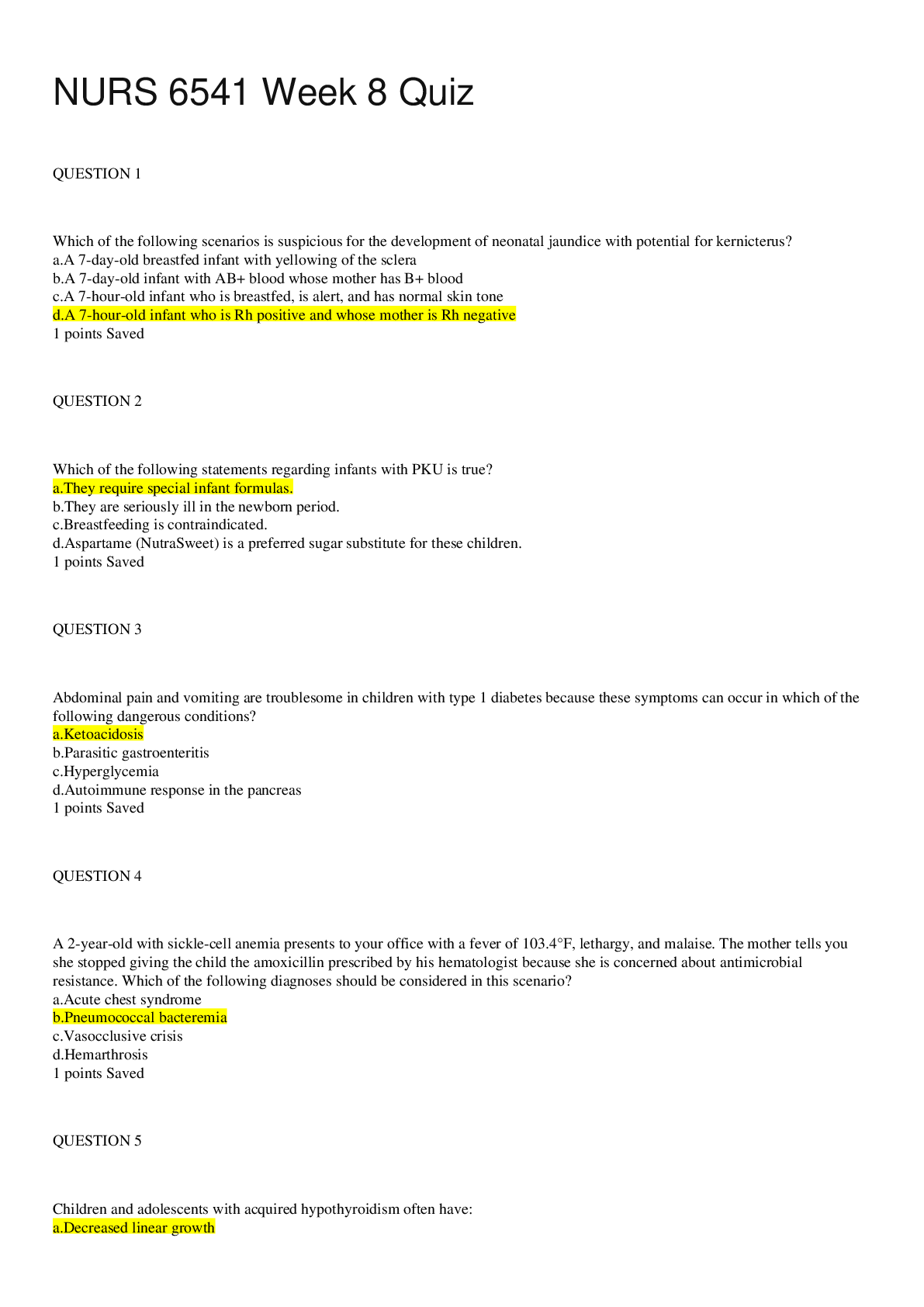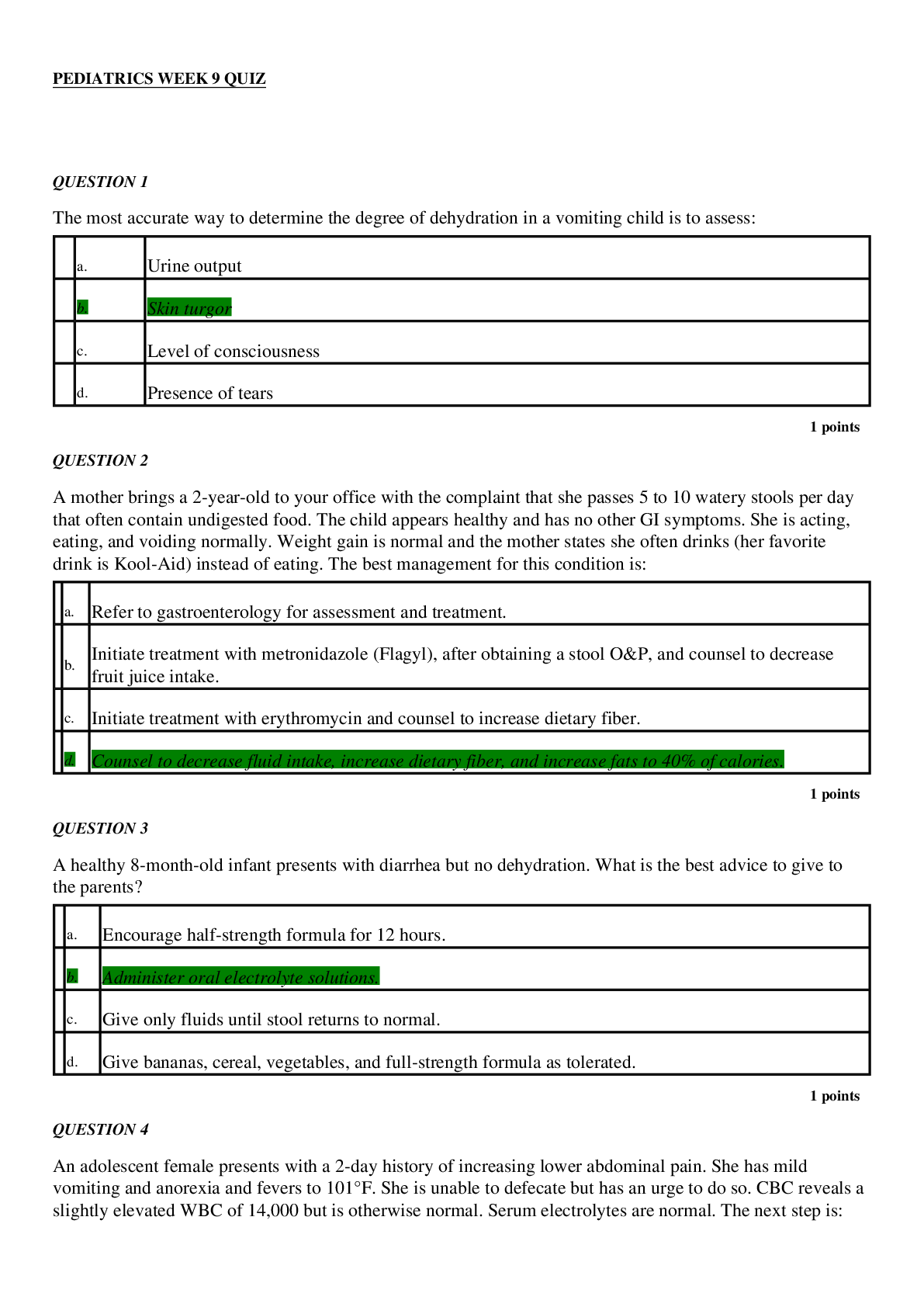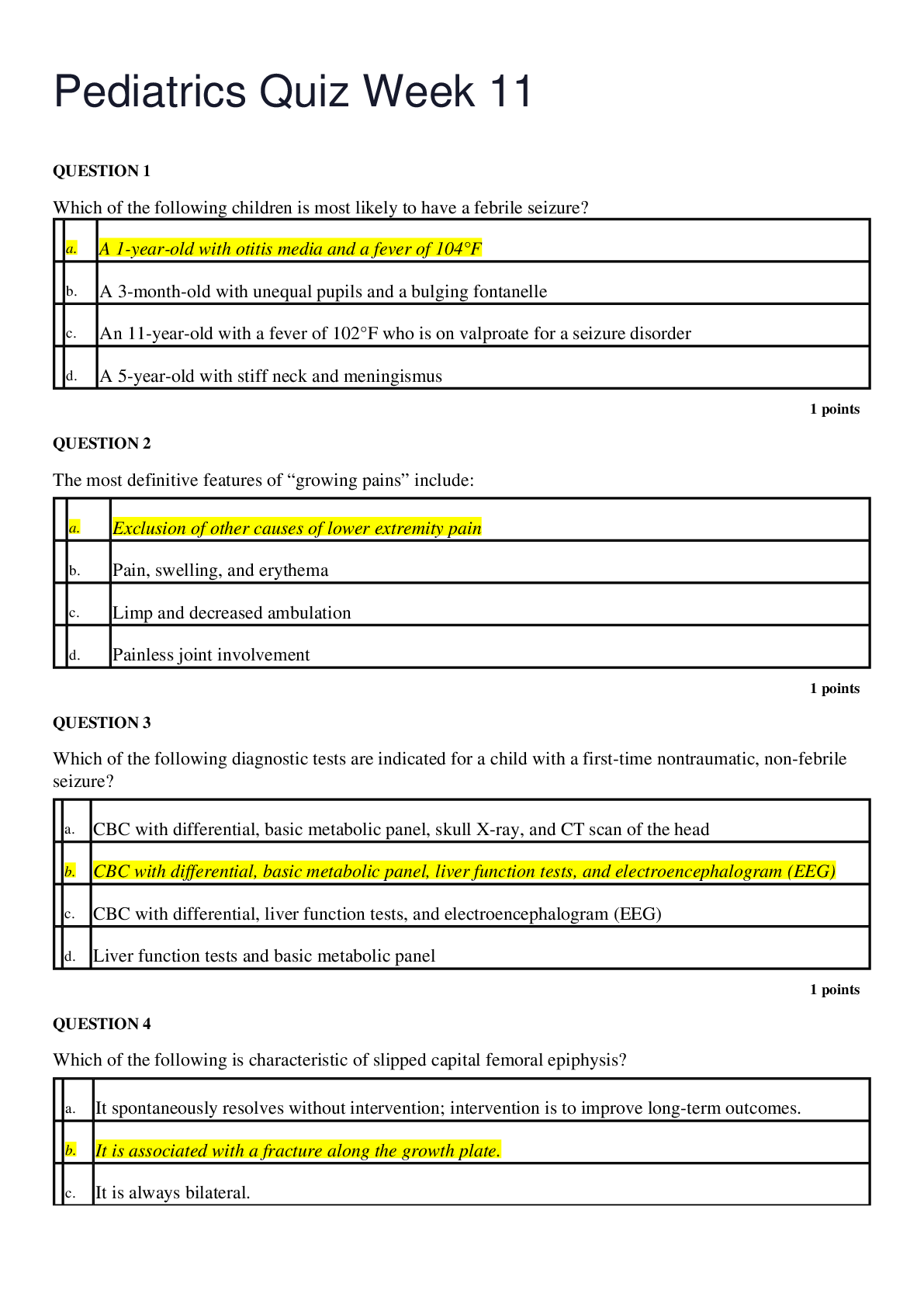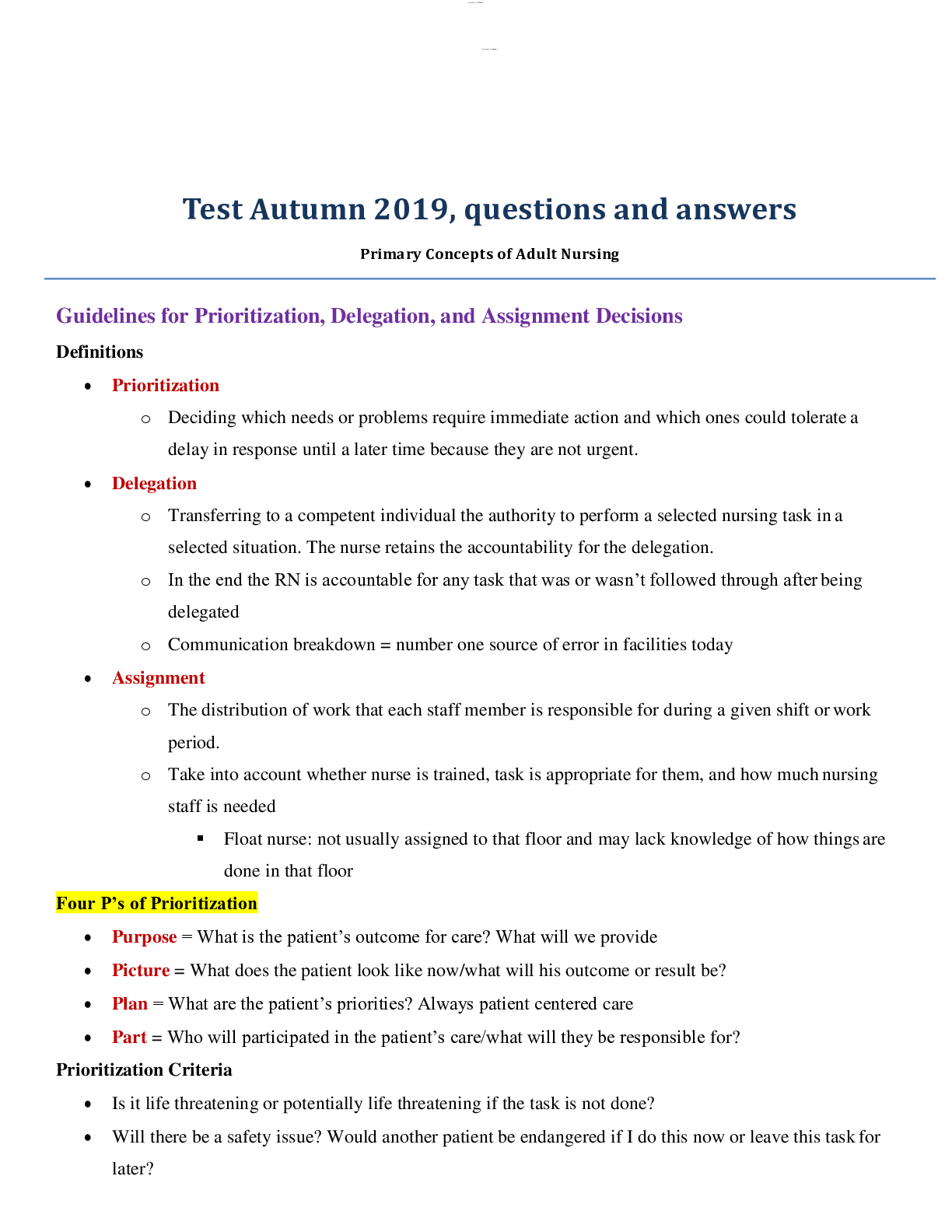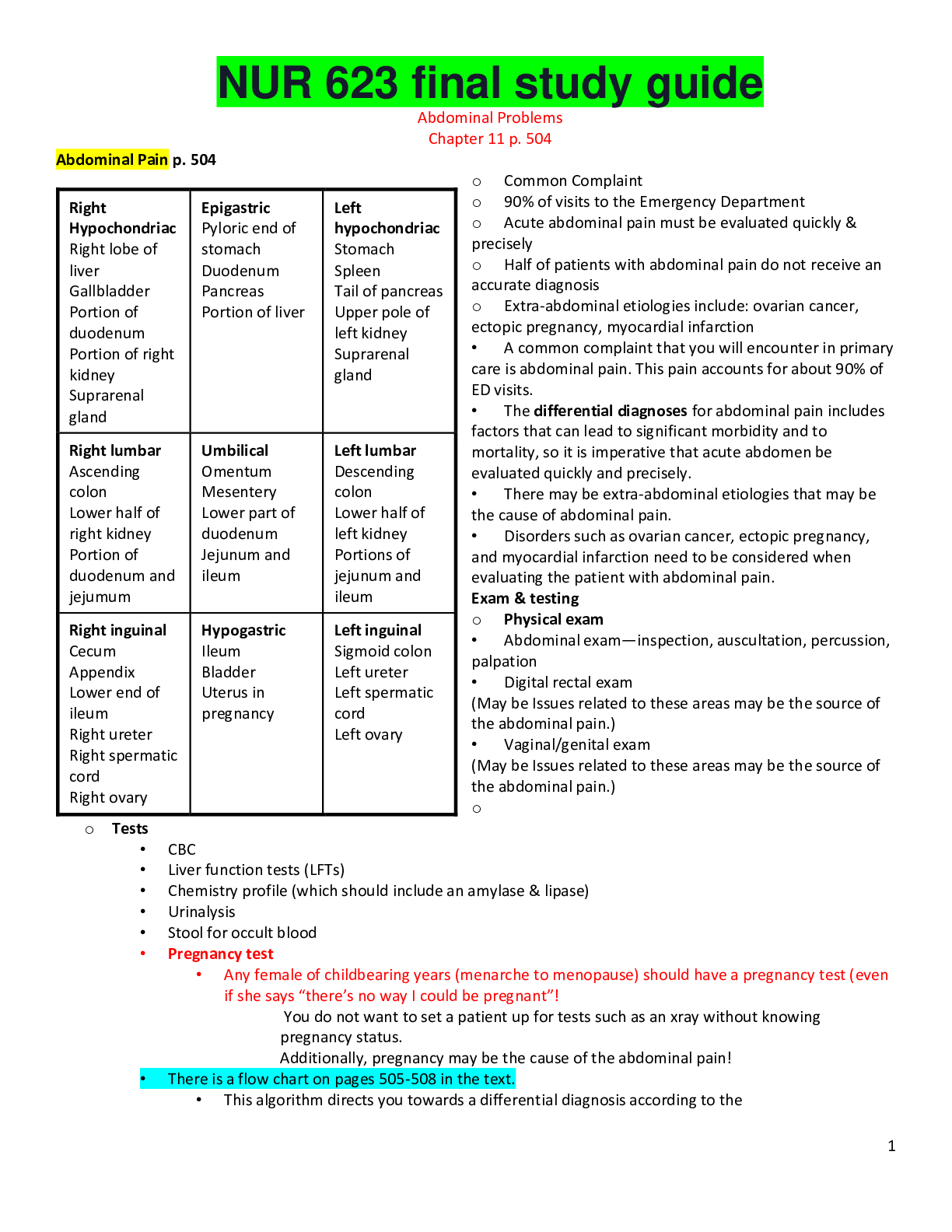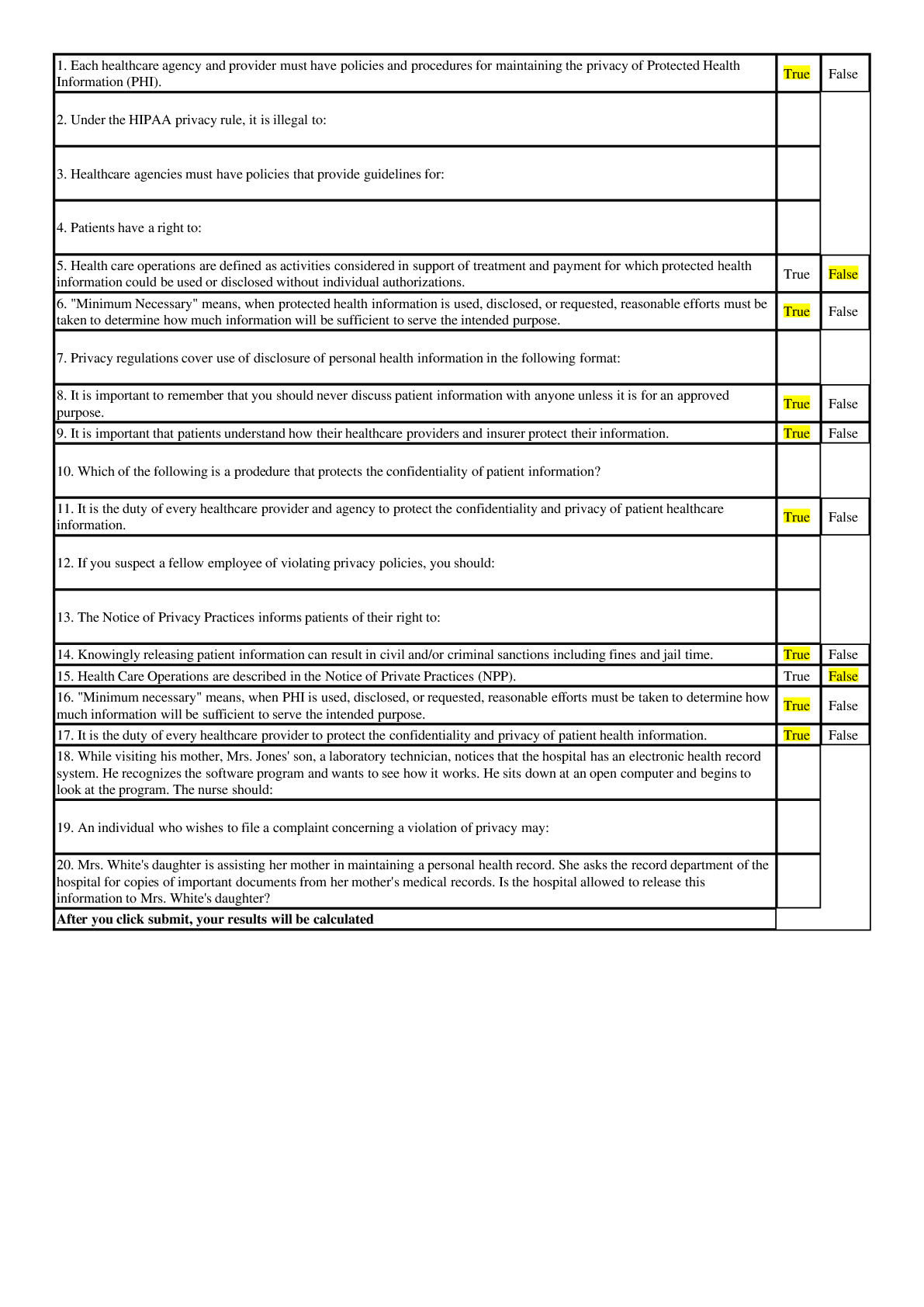Health Care > STUDY GUIDE > OEC Test Study Guide - Questions and Answers (Complete Solutions) (All)
OEC Test Study Guide - Questions and Answers (Complete Solutions)
Document Content and Description Below
OEC Test Study Guide - Questions and Answers (Complete Solutions) While in the aid room treating a patient with a fractured wrist, the patient tells you that he was skiing on a slope that was too di... fficult for him, and that he started going too fast and got out of control. You recognize that this information must be documented on the accident report because it provides evidence of: a. gross negligence. b. assumption of risk. c. contributory negligence. d. willful negligence. The type of consent that is based on an appreciation and understanding of the facts, implications, and possible future consequences of an action is known as: a. implied consent. b. educated consent. c. expressed consent. d. informed consent. You have just finished your shift, and while driving home still wearing your patrol jacket you come upon a car collision in which people appear to be injured. You recognize that if you approach the collision wearing your patrol jacket, members of the public may have a reasonable expectation that you will provide care. This expectation is known as: a. the absence of negligence. b. professional ethics. c. moral obligation. d. the doctrine of public reliance. The first emergency responder textbook created exclusively for ski patrollers was titled: a. Winter Emergency Care. b. Outdoor Emergency Care. c. Ski Safety and First Aid. d. Safety on the Snow. Although the National Ski Patrol was originally a subcommittee of the National Ski Association, the NSP became an independent organization in: a. 1953. b. 1980. c. 1962. d. 1975. Which of the following is not an ethical principle that OEC Technicians should follow? a. Do not provide an intervention that could cause further harm. b. Promote the health and well-being of others. c. Treat others as you would wish to be treated. d. Protect others and never let them refuse care. What type of consent would apply for an unresponsive 28-year-old male victim of a motorcycle collision? a. Expressed consent b. Implied consent c. Informed consent d. Assumed consent The 5th Edition of Outdoor Emergency Care: a. must be learned in its entirety before taking the OEC Technician evaluation. b. contains the baseline knowledge and skills identified by the U.S. Department of Transportation curriculum for EMTs in all settings. c. exceeds the knowledge and skills identified by the U.S. Department of Transportation for Emergency Medical Responder. d. can only be taught in the winter so that students can practice the skills taught in the course. Dr. Warren Bowman is considered the father of Outdoor Emergency Care because he: a. was the first program director for the National Ski Patrol. b. co-authored the first ski patrol manual with the American Red Cross. c. founded the National Ski Patrol as a separate entity. d. created the concept of "intermediate" medical care for ski patrollers. Which of the following descriptions is the best example of expressed consent? a. A 37-year-old man who is found unresponsive b. A 52-year-old skier who comes to the aid room and asks for help c. A 19-year-old male who appears to be intoxicated and lets you examine him d. A man who asks you to help his unresponsive 29-year-old diabetic wife A situation in which an OEC Technician leaves a patient before the patient's care is transferred to another qualified individual is considered: a. negligence. b. breach of duty. c. abandonment. d. assault. Which of the following statements about OEC 5th Edition is false? a. It contains the most recent information about prehospital care at the time of its publication. b. It is a resource text for the NSP OEC course. c. It is to be used by instructors to teach students the basic concepts of care. d. It supersedes local medical direction and management directives. The person who first organized a volunteer "ski patrol" and then was asked to organize a national patrol was: a. Roger Langely. b. Roland Palmedo. c. Minnie Dole. d. Warren Bowman. It is a busy Friday night in the aid room when a child arrives complaining of abdominal pain. The child states that her parents dropped her off and that they are at the movies. You are concerned because the child is a minor with no adult to give consent for treatment. You would: a. recognize that you need the parents' consent and try to reach them by phone. b. recognize that the child needs to be assessed and that there is implied consent to treat. c. recognize that you must have some adult's permission and try to locate an aunt or an uncle. d. do as much of an assessment as possible without touching the child to determine if a life-threatening emergency exists. You are skiing down your favorite slope and notice a small group gathered around a middle-aged man sitting on the ground. You note that the boarder is holding his wrist and appears in pain. He agrees to have you examine him but then refuses any more help. You explain the possible consequences of not splinting the wrist and of the boarder trying to get down the mountain without help. This explanation of the risk of refusing care is provided in order to: a. demonstrate that you know how to treat a wrist injury. b. diminish your risk of being accused of abandonment. c. reduce your risk of an accusation of battery. d. help the patient understand why you are about to put the splint on anyway. The creed of the National Ski Patrol is: a. "Skiing and Safety." b. "First Aid and Service." c. "Snowsports and Safety." d. "Service and Safety." While you are alone and caring for an injured skier in the aid room, a fellow patroller calls and tells you that your own young child was just injured in the terrain park. Concerned for your child, you leave the patient's care unfinished and run to the terrain park. Your action could be viewed as: a. a breach of ethics. b. your duty to act. c. denial of care. d. abandonment. Although not required in OEC 5th Edition, your local mountain protocol states that any time you use a backboard you should always treat the patient as having a neck/back injury and apply a cervical collar. You recognize that this mountain-specific requirement is called a: a. standard of training. b. standard of care. c. medical standard. d. duty to act. Which of the following is not considered a form of patient consent? a. Informed consent b. Minor consent c. Implied consent d. Absolute consent In order to become an "on the hill" Alpine patroller, you need to do all of the following except: a. complete the OEC course. b. successfully complete a written exam and a practical exam. c. demonstrate a level of skiing/boarding and toboggan handling proficiency. d. successfully complete a three-month candidacy program at your mountain. Upon finding an unconscious patient at the scene of a bad accident, your next step should be to: a. assume "implied consent" and begin to examine and treat the patient. b. delay your examination and ask other patrollers to respond as witnesses. c. delay your examination until you can locate a spouse or a friend of the patient. d. begin your assessment but not provide any treatment until another patroller arrives. The course called "Outdoor Emergency Care" was created by the National Ski Patrol to: a. create a standard of care for ski patrollers and others involved in outdoor emergency care. b. provide a standard of training for OEC Technicians and others involved in outdoor recreation. c. respond to a request from Minnie Dole to develop training for patrollers working at ski resorts. d. create a worldwide standard of care for anyone providing outdoor emergency care. Which of the following statements concerning "standard of training" is true? a. Acting within the "standard of training" is fundamental to reducing an OEC Technician's legal risk. b. "Standard of training" is the same thing as "standard of care." c. "Standard of training" includes the mountain area's protocols. d. "Standard of training" includes your state's laws and procedures. Most teaching systems have found that the most effective way to master technical skills is by: a. personally practicing the skills. b. observing others doing the skills. c. memorizing the skill guides in a book. d. teaching the skills to a class. Although regulations may differ from state to state, the general laws that may protect OEC Technicians from liability while providing emergency care to a patient are known as: a. emergency rescue protection laws. b. Good Samaritan laws. c. volunteer rescue liability laws. d. first rescuer liability laws. The National Ski Patrol is one of a few organizations that have received a federal charter from the U.S. government. Because of this, each year the NSP must: a. ensure that all patrollers refresh their training. b. report to Congress. c. submit names of all patrollers to the IRS. d. submit a tax return to the IRS. The 10th Mountain Division was founded: a. through a request from the U.S. president to Minnie Dole. b. after Minnie Dole convinced the U.S. Army that a winter warfare unit would be valuable. c. by members of the 87th Mountain Infantry Regiment, many of whom were skiers. d. through the Norwegian Army, which had a cold-weather unit during World War I. You arrive at the scene of an accident where a 22-year-old female skier has hit a tree and has a large bleeding cut on her head. When you ask her if she needs help, she refuses care and says she just needs to sit for a while. Noticing the amount of bleeding, you calmly express your concern for her, but she continues to say she doesn't want help. You hesitate to touch her because you are concerned that if you do, she could accuse you of: a. assault. b. battery. c. breach of duty. d. duty to act. In order to maintain OEC certification, you must: a. complete a refresher course that covers one-third of the curriculum every year. b. complete a refresher course that covers the key objectives of the entire curriculum every year. c. complete a refresher course that covers the key objectives of the entire curriculum every three years. d. demonstrate CPR and AED skills every two years. Good Samaritan laws generally: a. protect a ski patroller from being sued in every circumstance. b. apply to people who do not receive compensation for helping people. c. are the same in every state. d. provide enough protection so that you need not to know whether your mountain has insurance. The failure to exercise the care that a reasonably prudent person with similar training would exercise in a similar circumstance is known as: a. negligence. b. assault. c. gross negligence. d. standard of care breach. When you approach an injured skier and ask, "May I help you?" and she replies "Yes," you interpret this "expressed consent" to mean that: a. you can examine and treat the patient. b. you can examine, treat, and transport the patient. c. you can only examine the patient. d. you can only ask the patient to provide a history. Guidelines developed at the local level by emergency personnel familiar with an area's medical needs, available resources, system capabilities, and local standard of care are: a. protocols. b. policies. c. advanced procedures. d. medical attributes. When speaking to another person over the airwaves, the use of radio codes: a. decreases confusion in communication. b. is preferred so that the public cannot understand your transmission. c. is discouraged because the codes are not universal to all public safety agencies. d. is required when everyone on your patrol is trained. What do you say using the NATO Phonetic Alphabet to ensure that the letters SMD are understood? a. "Saltine Mary Diamond" b. "Saltine Mike Delta" c. "Sierra Mike Delta" d. "Sierra Mary Diamond" Which of the following methods is the best method for ensuring that the treatment rendered by OEC Technicians meets or exceeds customer expectations and national education standards for emergency medical personnel? a. Public education b. Prevention training c. Continuity of care d. Quality improvement Which of the following choices is not an example of direct medical oversight? a. Telephone communication b. Physical presence of a physician c. Written protocols d. Video conferencing The seamless delivery of high-quality emergency medical care as a patient transitions from initial contact with an EMT through definitive treatment best describes: a. medical direction. b. continuity of care. c. integration of health services. d. online medical control. An OEC Technician meets or exceeds the NHTSA national training requirements of: a. an Emergency Medical Technician. b. an advanced Emergency Medical Technician. c. a Paramedic. d. an Emergency Medical Responder. The reason it is important that OEC Technicians participate in quality improvement programs in services in which they work or volunteer is: a. to guarantee that the public receives quality emergency medical care. b. to identify problems in care delivery and develop a plan to prevent their recurrence. c. to ensure that individuals making false calls for help are prosecuted. d. to identify problem employees and create a corrective action plan for them. Which of the following tips is not a part of common radio etiquette? a. Speak directly into the microphone. b. Hold the transmit key in for 1-2 seconds before speaking. c. Include detailed information in a single transmission that takes no longer than 60 seconds. d. Do not use the patient's name. Which of the following levels of training emphasizes the provision of immediate life-saving treatment and stabilization to critically ill or injured patients while waiting for additional emergency response? a. EMT b. Emergency medical responder c. AEMT d. Critical care responder Which of the following is not one of the four nationally recognized prehospital emergency care provider levels? a. Emergency Medical Technician b. Advanced Emergency Medical Technician c. Outdoor Emergency Care Technician d. Emergency Medical Responder Many emergency care systems deploy personnel to emergencies using a tiered approach. OEC Technicians are most likely deployed in which tier? a. Tier 1 b. Tier 2 c. Tier 3 d. Tier 4 Critical care providers who bring advanced life support equipment, therapies, and interventions to the scene are typically deployed in what tier? a. Tier 1 b. Tier 2 c. Tier 3 d. Tier 4 Which of the following characteristics is not a characteristic of indirect medical control? a. Communication by radio b. Use for expediting patient care c. Common use for "pre-authorizing" routine and life-saving procedures d. Provision through the use of protocols What time is 6:43 a.m. in military time? a. 1843 b. 0643 c. 1243 d. 2343 Which of the following is most effective for reducing the incidence of injury or illness in skiing or other outdoor activities? a. Clinical care b. Public access c. Prevention d. Emergency personnel Which of the following is not an attribute of an emergency care system? a. Equipment b. Public access c. Human resources d. Research Most emergency care systems deploy personnel to emergencies using a stratified approach based on the patient's condition or anticipated needs. Which of the following lists presents the normal order of deployment of responders? a. EMT, AEMT, EMR, Paramedic b. EMR, AEMT, Paramedic, EMT c. EMR, EMT, AEMT, Paramedic d. AEMT, Paramedic, EMT, EMR Which of the following is the umbrella under which every facet of health care is sheltered? a. Community wellness programs b. Research c. The emergency care system d. Public health Which of the following is not a role of OEC Technicians in the quality improvement process? a. Participating in training b. Being receptive to on-scene instructions given by another rescuer c. Blaming their partner for a mistake in care d. Participating in case reviews Which of the following attributes is not one of the 14 attributes of an effective emergency care system? a. Integration of health services b. System finance c. Public access d. Public acceptance Written instructions that indicate what should be done in a given situation are best described as: a. regulations. b. protocols. c. indirect medical oversight. d. direct medical oversight. What is 3:35 p.m. in military time? a. 0335 b. 1535 [Show More]
Last updated: 1 month ago
Preview 1 out of 70 pages

Buy this document to get the full access instantly
Instant Download Access after purchase
Add to cartInstant download
We Accept:

Reviews( 0 )
$20.00
Document information
Connected school, study & course
About the document
Uploaded On
May 30, 2024
Number of pages
70
Written in
Additional information
This document has been written for:
Uploaded
May 30, 2024
Downloads
0
Views
9




